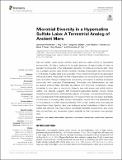| dc.contributor.author | Walker, Virginia K. | |
| dc.contributor.author | Hepburn, Holli | |
| dc.contributor.author | Ruvkun, Gary | |
| dc.contributor.author | Pontefract, Alexandra Janine | |
| dc.contributor.author | Zhu, Ting | |
| dc.contributor.author | Zuber, Maria | |
| dc.contributor.author | Lui, Clarissa S. | |
| dc.contributor.author | Carr, Christopher E. | |
| dc.date.accessioned | 2018-03-06T23:25:32Z | |
| dc.date.available | 2018-03-06T23:25:32Z | |
| dc.date.issued | 2017-09 | |
| dc.date.submitted | 2017-06 | |
| dc.identifier.issn | 1664-302X | |
| dc.identifier.uri | http://hdl.handle.net/1721.1/114037 | |
| dc.description.abstract | Life can persist under severe osmotic stress and low water activity in hypersaline environments. On Mars, evidence for the past presence of saline bodies of water is prevalent and resulted in the widespread deposition of sulfate and chloride salts. Here we investigate Spotted Lake (British Columbia, Canada), a hypersaline lake with extreme ( > 3 M) levels of sulfate salts as an exemplar of the conditions thought to be associated with ancient Mars. We provide the first characterization of microbial structure in Spotted Lake sediments through metagenomic sequencing, and report a bacteria-dominated community with abundant Proteobacteria, Firmicutes, and Bacteroidetes, as well as diverse extremophiles. Microbial abundance and functional comparisons reveal similarities to Ace Lake, a meromictic Antarctic lake with anoxic and sulfidic bottom waters. Our analysis suggests that hypersaline-associated species occupy niches characterized foremost by differential abundance of Archaea, uncharacterized Bacteria, and Cyanobacteria. Potential biosignatures in this environment are discussed, specifically the likelihood of a strong sulfur isotopic fractionation record within the sediments due to the presence of sulfate reducing bacteria. With its high sulfate levels and seasonal freeze-thaw cycles, Spotted Lake is an analog for ancient paleolakes on Mars in which sulfate salt deposits may have offered periodically habitable environments, and could have concentrated and preserved organic materials or their biomarkers over geologic time. | en_US |
| dc.description.sponsorship | United States. National Aeronautics and Space Administration (Award NNX08AX15G) | en_US |
| dc.description.sponsorship | United States. National Aeronautics and Space Administration (Award NNX15AF85G) | en_US |
| dc.publisher | Frontiers Research Foundation | en_US |
| dc.relation.isversionof | http://dx.doi.org/10.3389/fmicb.2017.01819 | en_US |
| dc.rights | Attribution 4.0 International (CC BY 4.0) | en_US |
| dc.rights.uri | https://creativecommons.org/licenses/by/4.0/ | en_US |
| dc.source | Frontiers | en_US |
| dc.title | Microbial Diversity in a Hypersaline Sulfate Lake: A Terrestrial Analog of Ancient Mars | en_US |
| dc.type | Article | en_US |
| dc.identifier.citation | Pontefract, Alexandra et al. “Microbial Diversity in a Hypersaline Sulfate Lake: A Terrestrial Analog of Ancient Mars.” Frontiers in Microbiology 8 (September 2017): 1819 © 2017 The Authors | en_US |
| dc.contributor.department | Massachusetts Institute of Technology. Department of Earth, Atmospheric, and Planetary Sciences | en_US |
| dc.contributor.mitauthor | Pontefract, Alexandra Janine | |
| dc.contributor.mitauthor | Zhu, Ting | |
| dc.contributor.mitauthor | Lui, Clarissa Shiao-Jia | |
| dc.contributor.mitauthor | Zuber, Maria | |
| dc.contributor.mitauthor | Carr, Christopher E | |
| dc.relation.journal | Frontiers in Microbiology | en_US |
| dc.eprint.version | Final published version | en_US |
| dc.type.uri | http://purl.org/eprint/type/JournalArticle | en_US |
| eprint.status | http://purl.org/eprint/status/PeerReviewed | en_US |
| dc.date.updated | 2018-02-16T19:33:39Z | |
| dspace.orderedauthors | Pontefract, Alexandra; Zhu, Ting F.; Walker, Virginia K.; Hepburn, Holli; Lui, Clarissa; Zuber, Maria T.; Ruvkun, Gary; Carr, Christopher E. | en_US |
| dspace.embargo.terms | N | en_US |
| dc.identifier.orcid | https://orcid.org/0000-0003-2652-8017 | |
| mit.license | PUBLISHER_CC | en_US |
